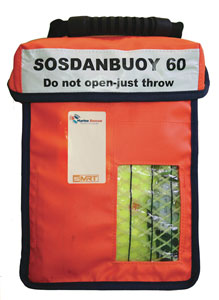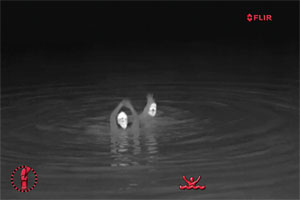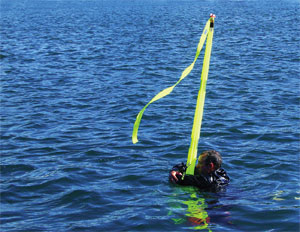It wasn’t long ago that “man overboard” meant lost at sea. Luck was your only friend if you hoped to be recovered before drowning or succumbing to hypothermia as your vessel circled back to look for you — if your fellow crewmembers even knew you were missing. Your chances were better in a brownwater incident, but being overboard and adrift often had the same fatal consequence.
The advent of advanced electronics has improved the odds, led by personal locator beacons, EPIRBs and, more recently, the automatic identification system (AIS) and thermal imaging cameras. AIS in particular has emerged as an effective search-and-rescue tool, adding to its original role of helping ships avoid collisions at sea.
Companies providing search-and-rescue devices are increasingly incorporating AIS into new products to give rescuers a better chance of finding their target in man-overboard (MOB) incidents. One of the latest and most innovative items is the sMRT SOS Dan Buoy from U.K.-based Marine Rescue Technologies Ltd.
The Dan Buoy, designed to be tossed to the victim in a “sighted” MOB incident, combines the company’s V100 personal locator beacon with an inflatable buoy in a compact pouch. The pouch is stored in an all-weather case that can be mounted anywhere on a vessel or offshore platform.
Within seconds of immersion, the bright-yellow buoy deploys from the pouch and rises more than 6 feet above the water line. Webbing loops allow the mariner to keep his arms wrapped around the buoy for extra support if he is becoming fatigued.
As the buoy is inflating, the locator beacon automatically transmits GPS coordinates to the vessel’s chartplotter via AIS. The unit can then be tracked up to 150 miles away while alerting the captain by VHS DSC radio that a crewmember has gone overboard. For night incidents, the buoy has a strobe light to increase the probability of rescue.
“Having an auto-inflating, highly visible flotation device that alerts and tracks someone overboard is a vast improvement on an old-fashioned life ring or traditional danbuoy,” said Jon Gething, director of Marine Rescue Technologies. “New international safety standards include alerting and tracking technologies that are incorporated into personal life jackets for MOB protection. This product is an extension of this.”
The company partnered on the SOS Dan Buoy with SOS Marine of Australia, a 30-year manufacturer of maritime safety and rescue equipment. The product was introduced last year and thus far has made inroads primarily in the recreational market, but Gething said there has been “significant interest” from commercial operators as well.
“There are a number of organizations — including offshore energy, deep-sea fishing, port and harbor authorities, cruise vessels and more — actively pursuing best-of-breed man-overboard solutions,” he said.
Another recent market entry that improves the outlook for overboard mariners is McMurdo Group’s Smartfind S20, a personal MOB device that builds on the success of the company’s S10. Unlike its hand-held predecessor, the S20 is designed to be worn on a PFD or survival suit. What it shares with the S10 is its capability and AIS compatibility.
 |
|
Below, the inflatable device comes ready to deploy in a compact, easy-to-toss pouch. |
|
Courtesy Marine Rescue Technologies |
The S20 is activated by sliding off the safety tab and lifting an arming cap to deploy the antenna. It then sends alert messages, GPS position and an identity code to AIS-enabled receivers within a four-mile radius. The unit’s GPS receiver updates every 60 seconds to provide precise location data. A flashing LED light aids searchers at night.
Bill Eastwood, Americas sales manager for France-based McMurdo Group, said the adoption of AIS-enabled MOB devices has been gaining in the commercial marine sector but is still fairly conservative.
“Some of it is just education, just getting the concept out there,” Eastwood said. “It’s brilliant because if you have AIS you have the receiving end, which means a big piece of the expense is already in place. One of the things we’ve been finding, especially among some of the fishing industry guys, is that if it’s not mandated then they don’t want to take on the expense.”
Eastwood said he has talked to operators of offshore supply vessels in the Gulf of Mexico who require AIS MOB devices for their crews but don’t provide them.
“(The operators) love the idea, but then they want their crew to buy them,” he said. “Some of us have been asking if down the road, if underwriters or folks who are insuring some of these larger fleets get involved, will there be a financial benefit to companies mandating that their crews wear these devices? The low-hanging fruit would be deck hands who are already required to wear a life jacket.”
The adoption rate could improve in the next year due to new AIS regulations issued by the U.S. Coast Guard. According to a final rule published this year, an expanded list of vessels will be required to have an operational AIS transponder — some Class A and some Class B — no later than March 1, 2016. The list includes all commercial vessels 65 feet or longer; towing vessels 26 feet or longer with more than 600 hp; and vessels certified to carry more than 150 passengers.
“That adds potentially 4,500 to 5,500 vessels nationwide that will now be required to carry AIS that previously were not,” Eastwood said. “The nice thing about AIS is that if you’re inclined to think about man-overboard devices, it’s a much less expensive option if you already have AIS in place.”
Another tool increasingly coming into play for MOB recovery is the thermal imaging camera. SCF Marine, a towboat and barge service provider headquartered in St. Louis, Mo., recently began deploying M Series thermal cameras from Oregon-based FLIR Systems.
Tim Robinson, safety and compliance officer for SCF Marine, said the company has 17 towboats that have a FLIR thermal camera installed atop the wheelhouse. The cameras are pointed toward the tow, with controls and a flat-screen display in the house for monitoring. The cameras are linked to a DVR for future video review.
Robinson said the cameras provide obvious benefits when it comes to navigation, helping boat crews locate obstructions and oncoming vessels and find safe harbor in a thunderstorm or snow squall. But SCF Marine also looked at the value of the technology in an MOB incident.
“That was definitely one of the considerations, a man-overboard situation,” Robinson said.
 |
|
Thermal imaging cameras can improve the odds of recovery in man-overboard incidents that occur at night or in stormy weather. St. Louis-based SCF Marine has deployed FLIR’s M Series cameras on 17 of its towboats. |
|
Courtesy FLIR Systems |
He said all of the company’s crews are provided with ALERT2 personal transmitters — typically affixed to their flotation vests — which activate when submerged. A radio signal is transmitted to a receiver in the wheelhouse, a siren sounds and a red “man overboard” light is illuminated. Other SCF boats in the area up to 1 nm away can receive the alert.
Robinson said there has never been a situation at SCF when the transmitters, made by Emerald Marine Products of Seattle, have come into play for an MOB rescue. If it ever happens, the FLIR thermal cameras can provide a valuable assist — especially if the incident occurs at night or in stormy weather.
“It’s something you hope you never have to use, but it’s good to know it’s there to fall back on,” he said.
Haley Ellison, a spokeswoman for FLIR, said the company did not have statistics on the number of rescues that its cameras have helped facilitate. That is typically the case for manufacturers of MOB personal locators as well because the incidents often aren’t reported.
“It allows self-rescue, so you’re not involving search-and-rescue authorities,” said Sean McCrystal, marketing manager for global SAR solutions for McMurdo Group. “Smaller incidents that in the past led to tragedy are now being avoided by the ability to alert and recover people yourself without having to wait for outside help. The flip side of that is you don’t necessarily have to inform anyone of the incident or the use of the equipment, so it’s much more difficult to track. On the commercial side, we don’t tend to get that information sent back to us.”
One sector where MOB incidents have been getting a lot of attention lately is the cruise ship industry. Ellison said several major cruise lines have invested heavily in FLIR’s equipment as a preventive measure.
“As you know, this has been a great concern to passenger vessel operators over the last several years,” she said, adding that the company’s technology is evolving to keep pace. “We’re constantly working to improve the level of integration between FLIR thermal camera systems and other hardware and software systems. Recovering a person from the water is imperative, but the real challenge is to be able to prevent it from happening in the first place.”

